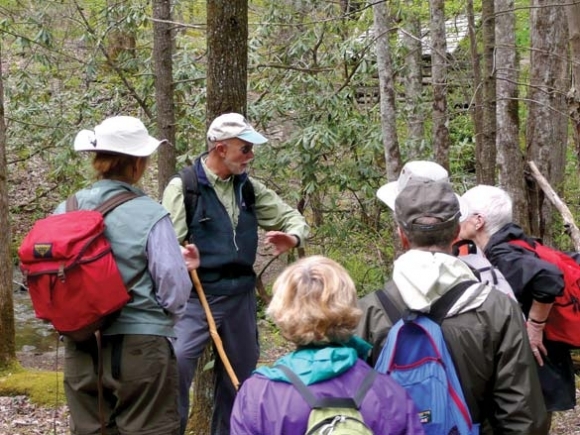Catalyst for adventure: Field school instructors reflect on three decades in the Smokies

The Smoky Mountain Field School was only a couple years old when Joel Zachary came on as an instructor in 1980. Kathy Zachary — then his girlfriend, now his wife — joined him in 1983, and the field school has been part of their lives ever since.
“We like to say that the success of the program is due to the instructors we have that are so enthusiastic about their topics,” Kathy said. “They have a passion for teaching and sharing, so the person who signs up to take a course really gets that contagious enthusiasm that the instructor shares.”
This year marks the field school’s 40th anniversary, a partnership of the University of Tennessee and the Great Smoky Mountains National Park that aims to give people a chance to experience the park in the company of experts in fields such as botany, geology, dendrology, orienteering and everything in between. More than 20 experts teach more than 50 non-credit sessions in each March through November season, using the park as a classroom to enhance their students’ understanding of the natural world.
“A lot of people that enjoy going out with our instructors not only learn with them, but they also feel a degree of safety,” Joel said.
There are plenty of people who like the sound of spending a night in the woods or hiking through forests inhabited by bears and wild hogs but would never dare to plan such an adventure on their own. With a seasoned instructor leading the way, they’re good to go.
“Sometimes it’s the catalyst that develops that lifelong love of hiking, backpacking, whatever it is,” Joel said.
Related Items

For the past six years, the Zacharys have been serving as directors of the field school, as well as instructors, working to expand the course offerings to provide a more varied array of topics. This November will mark their retirement from that role, but not from the field school, and certainly not from the world of outdoor leadership.
“We do way too much is what it boils down to,” Kathy laughed during a phone interview as she and Joel drove home from a weeklong trip with the travel company they run.
The Zacharys have no plans to stop teaching field school courses, but at this point they’re looking forward to having some more time for other pursuits after stepping back from the director’s role. The plan is for those functions to be absorbed by the field school’s existing full-time staff.
Joel has a few books in his head he’d like to write, and Kathy’s still weighing her options, though it’s a fair guess that they’ll both stay busy.
In addition to the field school, they lead trips through their travel company Great Outdoors Adventure Travel — GOAT, for short — exploring the wilderness in a variety of settings, including Alaska, where they spend three months each year. They also co-wrote Bears we Met: Short Stories of Close Encounters, and often find themselves asked to give talks and presentations.
But the field school occupies a special place on that list of commitments. It’s been a long-term relationship, and a fruitful one.
“Kathy and I were always very free to comment that some of the most treasured friends we have, we’ve met through the Smoky Mountain Field School, and that is absolutely the truth,” Joel said.
They are grateful to have built a career that allows them to spend so much time in the great outdoors, but equally so to spend that time in the company of likeminded people who are eager to share their passion for exploration.
For many of the field school participants, hiking is something they enjoy but not something they have the chance to do on a regular basis. The Zacharys enjoy seeing the transitions that can take place over the course of a few hours or a few days.
For example, Joel said, he’ll frequently have the hiking group pause when he spots a deposit of animal droppings, showing them the pieces of bone and hair that indicate what that animal’s last meal was.
“Some people are kind of grossed out by that, but by the end of the day they’re packed with Ziplocks, taking them home with them,” he said. “They’ve found that’s a learning tool.”
Those moments are exciting, but others are notable for a whole other reason. When leading a group of five, 10, 15 or 20 strangers through the woods, Joel and Kathy are responsible for their safety, and that can be a heavy burden — especially when someone comes unprepared.
“People might think they’re prepared, and sometimes they may be kind of experienced in what you’re doing,” Joel said. “They’re worried about bears or mountain lions or stepping on a snake, and we’re worried about you dying of hypothermia.”
A backpacking wardrobe made of cotton can be dangerous with the temperature drops and rain falls — in the Smokies, hypothermia-related injuries are far more common than wildlife-related ones. It’s Kathy and Joel’s job to make sure everyone is as prepared as possible, and they must also be ready to deal with the myriad situations that can arise during an adventure in the backcountry.
“You have to take care of that weakest person, the person that has that issue,” Joel said. “And it could happen to one of us.”
With the advent of hiking boots featuring glued-on soles, rather than stitched like the old-school ones, an issue they’ve seen more and more is hikers’ soles peeling off mid-hike.
“We’ve had some hikers where both soles came off so they’re basically walking on their sock. And that’s a big deal,” Joel said.
The first time it happened, they were leading a group on a weeklong, 40-mile backpacking trip.
“On mile 3, the first sole came off,” Kathy said.
“And our shuttle had already dropped us off, so there was no going back,” Joel added.
“And a few miles later, the second one came off,” said Kathy.
They’ve developed a system for dealing with the issue. Both Kathy and Joel now carry a long set of shoe laces to wrap around errant soles, keeping them at least temporarily attached to the boot before it’s necessary to stop and rewrap. It’s never convenient, but at least it keeps hikers from being forced to walk over sticks and stones in their socks.
“We’ve never had a broken bone. We’ve never had severe bleeding or a snakebite,” Joel said. “But we take it very seriously, and we try to look after our folks and make them aware of what they’re doing and what they’re getting into.”
In a region with ample opportunity for outdoor recreation and a variety of free or low-cost guided outings to choose from, it can be hard to convince people that paying for a course taught by an expert is worth their while.
“There’s a lot of competition for these kinds of things,” Joel said.
But the Smokies Field School has certainly landed some winning courses. The fly fishing and orienteering classes have proven popular, as has an offering that allows people to experience the Smokies’ iconic synchronous firefly display in the company of an expert.
As to how many people have experienced the Smokies through the lens of the field school over its 40 years of existence, the Zacharys haven’t added that number up — though they can say it’s easily in the thousands. Joel said that he’d recently started a tally of the number of people he and Kathy had taken into the park — a figure that doesn’t include outings led by other instructors — and stopped counting at 3,000.
“If we helped change the behavior of people around bears or taught people to leave no trace or gave people incentive to get off the couch and get out there, that’s a worthy contribution,” he said.









